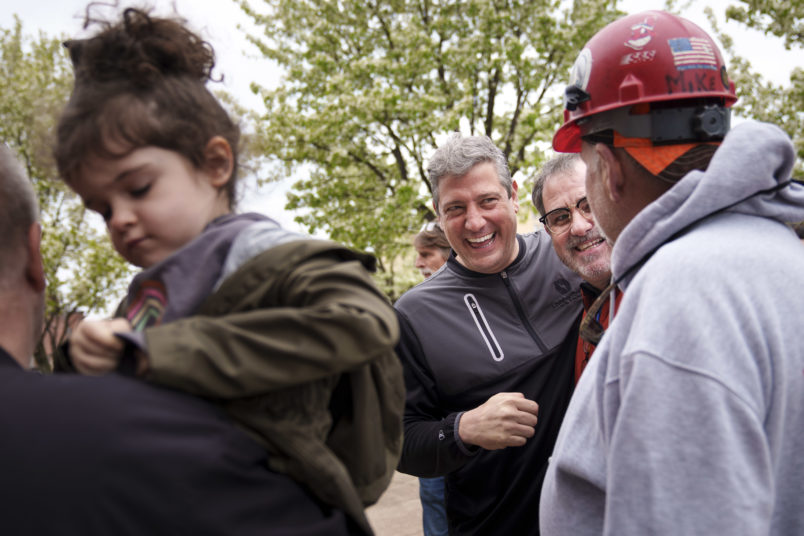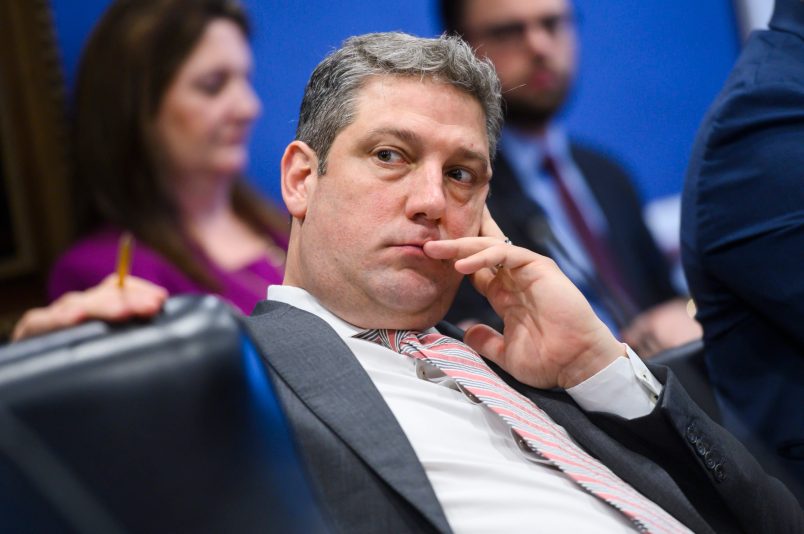This story was first published by ProPublica and The New York Times Opinion and is reprinted here under a Creative Commons license.
Tim Ryan is a “crazy, lying fraud.” That’s how J.D. Vance, the bestselling memoirist turned Republican Senate candidate from Ohio, opened his remarks at a September rally alongside Donald Trump in the middle of the congressional district Ryan has represented for two decades.
Ryan seems like an unlikely object of such caustic rhetoric. A 49-year-old former college-football quarterback, he is the paragon of affability, a genial Everyman whose introductory campaign video is so innocuous that it might easily be mistaken for an insurance commercial. His great passion, outside of politics, is yoga and mindfulness practice.
“We have to love each other, we have to care about each other, we have to see the best in each other, we have to forgive each other,” he declared when he won the Democratic Senate primary in May.
He isn’t just preaching kindness and forgiveness. For years, he has warned his fellow Democrats that their embrace of free trade and globalization would cost them districts like the one he represents in the Mahoning River Valley — and lobbied them to prioritize domestic manufacturing, which, he argued, could repair some of the damage.
His efforts went nowhere. Ryan failed in his bid to replace Nancy Pelosi as House minority leader in 2016. His presidential run in 2020 ended with barely a trace. And his opponent, Vance, was expected to coast to victory this year in a state that Trump carried twice by 8 points.
But things haven’t gone as predicted. Ryan is running close enough in the polls that a political action committee aligned with Mitch McConnell, the Republican Senate leader, has had to commit $28 million to keep the seat (now held by Rob Portman, who is retiring), and Vance has had to ratchet up his rhetorical attacks against this “weak, fake congressman.”
After years of being overlooked, Tim Ryan is pointing his party toward a path to recovery in the Midwest. On the campaign trail, he has embraced a unifying tone that stands out from the crassness and divisiveness that Trump and his imitators have wrought. A significant number of what he calls the “exhausted majority” of voters have responded gratefully.
And his core message — a demand for more aggressive government intervention to arrest regional decline — is not only resonating with voters but, crucially, breaking through with the Democratic leaders who presided over that decline for years. The Democrats have passed a burst of legislation that will pave the way for two new Intel chip plants in the Columbus exurbs, spur investment in new electric vehicle ventures in Ryan’s district and benefit solar-panel factories around Toledo, giving him, at long last, concrete examples to cite of his party rebuilding the manufacturing base in which the region took such pride.
In short, the party is doing much more of what Ryan has long said would save its political fortunes in the Midwest. The problem for him — and also for them — is that it may have come too late.
Tim Ryan was not always so alone in Congress. Manufacturing regions of the Northeast and Midwest used to produce many other Democrats like him, often with white-ethnic Catholic, working-class backgrounds and strong ties to organized labor. (Ryan’s family is Irish and Italian, and both his grandfather and great-grandfather worked in the steel mills.) One particularly notorious example of the type was James Traficant, who represented the Mahoning Valley in highly eccentric fashion and served seven years in prison after a 2002 conviction on charges that included soliciting bribes and racketeering. That left his young former staff member — Tim Ryan — to win the seat at age 29.
A few stalwarts remain: Marcy Kaptur, whose mother was a union organizer at a spark plug plant, will likely hold her Toledo-area House seat after her MAGA opponent lied about his military record. And Sherrod Brown, whose upbringing in hard-hit Mansfield and generally disheveled affect has lent authenticity to his own progressive populism (never mind the fact that he’s a doctor’s son and has a Yale degree), has survived two Senate reelections thanks to his personal appeal and weak opponents.

But nearly all the rest have vanished. Many of them fell victim to the Democratic wipeout in 2010. Others succumbed to the extreme Republican gerrymandering that followed. But central to their disappearance was the economic decline of the communities they represented, which was on a scale that remains hard for many in more prosperous pockets of the country to grasp.
In the first decade of this century, after Bill Clinton signed NAFTA in 1993 and ushered China into the World Trade Organization in 2000, so many manufacturing businesses closed in Ohio — about 3,500, nearly a fifth of the total — that its industrial electricity consumption fell by more than a quarter. Ryan’s district was among the most ravaged. By 2010, the population of Youngstown had fallen 60% from its 1930 peak, and it ranked among the poorest cities in the country.
For the Democrats representing these devastated areas, the fallout was enormous. “We were always supposed to be the party of working people, and so those rank-and-file union members kept getting crushed, and jobs kept leaving, and their unions and the Democrats weren’t able to do anything for them,” said Ryan, when I met with him in August, after an event he held at a substance abuse treatment program in Zanesville. Democratic candidates were also putting their attention elsewhere, on social issues, and voters noticed.
Ryan is determined not to make the same mistake. “You want culture wars?” he asks in one TV ad, while throwing darts in a bar. “I’m not your guy. You want a fighter for Ohio? I’m all in.”
In the 2000s, as Ryan saw his band of like-minded Democrats dwindle, he started looking for answers, and he found some of them at the Coalition for a Prosperous America, a small advocacy group founded in 2007 to promote American manufacturing and agriculture.
The group’s theory is fairly straightforward: The “free trade” that has been so ruinous to manufacturing regions like the Mahoning Valley has been anything but free, given all the various forms of support that other nations provide their own industries. The group has been lobbying members of both parties to consider explicit support for U.S. producers, whether in the form of tariffs or subsidies, even if it means brushing up against World Trade Organization rules.
For years, the Coalition for a Prosperous America and its allies in Congress ran up against free-trade orthodoxy. But growing alarm over climate change, the breakdown of global supply chains during the pandemic and Russia’s war against Ukraine have brought a stunning turnaround. The Inflation Reduction Act includes many of the kinds of policies that Ryan and CPA have championed, including refundable tax credits for solar-panel production, a 15% alternative minimum tax for corporations and requirements that electric vehicles have North American-made parts to qualify for consumer tax credits. This month, the Biden administration announced major new tech-export controls aimed at China, with the U.S. trade representative, Katherine Tai, declaring that free trade “cannot come at the cost of further weakening our supply chains.”

It’s a vindication for Ryan and his former House allies, such as Tom Perriello, who represented south-central Virginia between 2009 and 2011.
“The elite echo chamber assumed away all the human costs” of globalization, said Perriello, instead of realizing industries needed to be helped to save middle-class jobs.
Still, the shift has come only after tremendous economic losses for places like the Mahoning Valley and political losses for the Democrats. In the 2020 presidential election, Democrats lost white voters without college degrees by 26 percentage points nationwide, and their margins among working-class Black and Hispanic voters shrank, too. They lost Mahoning County, once a Democratic stronghold, for the first time since 1972.
“For the most part, people lost jobs here and Washington wasn’t doing anything for them,” said David Betras, the former chairman of the Mahoning County Democratic Party. “And then Trump came along and he said, ‘Hey, they screwed you.’ People thought: ‘At least he sees me. He’s giving me water.’” It might be contaminated water, as Betras noted, “but at least it’s water.”
Ryan’s attempt to point his party in a different direction in the Midwest is still running up against resistance, even as he has drawn close to Vance in the polls. The first ad released by Ryan’s campaign, in April, is Exhibit A.
Wearing an untucked shirt, he delivers a barrage against the threat presented by China: “It is us versus China and instead of taking them on, Washington’s wasting our time on stupid fights. … China is out-manufacturing us left and right. … America can never be dependent on Communist China. … It is time for us to fight back. … We need to build things in Ohio by Ohio workers.”
By the standards of the Ohio Senate race of 2022, it was pretty mild stuff. At an April rally with Trump, after completing his extreme pivot from Trump critic to acolyte, Vance lashed out at “corrupt scumbags who take their marching orders from the Communist Chinese.” But the Ryan ad nonetheless got opprobrium from Asian Americans, who said it risked fueling anti-Asian sentiment.
Irene Lin, a Democratic strategist based in Ohio, found that remarkable. “It’s so weird that he runs an ad attacking China, and people say, ‘You sound like Trump.’ Tim’s been attacking China for decades! Trump co-opted it from us and we need to take it back, because Trump is a complete fraud on this.”
Still, the episode underscored Ryan’s conundrum: how to match Trump and Vance when it comes to the decline of Ohio manufacturing without offending allies within the liberal Democratic coalition.
When I asked Ryan in Zanesville how he would distinguish his own views from those of Vance, he insisted it would not be difficult. For one thing, he noted, Vance has attacked a core element of the industrial policy that Ryan sees as key to reviving Ohio: electric vehicle subsidies. At the Mahoning rallies, Vance ridiculed them as giveaways for the elites, which, as Ryan sees it, overlooks the hundreds of workers who now have jobs at the old Lordstown General Motors plant in the Mahoning Valley, building electric cars, trucks and tractors as part of a new venture led by the Taiwanese company Foxconn, and at a large battery plant across the street.
“He’s worried about losing the internal-combustion auto jobs — dude, where’ve you been?” Ryan asked. “Those jobs are going. That factory was empty.”
Less than two months after Ryan’s anti-culture war ad, the Supreme Court issued its Dobbs ruling on abortion, bolstering Democrats’ prospects with moderate voters of the sort who help decide elections in places like suburban Columbus — and making it harder for Ryan to avoid hot-button social issues. He calls the ruling “the largest governmental overreach into personal lives in my lifetime,” but his continued focus on economic issues shows that he believes that’s not enough to win an election. Recent polls suggest he may be right.
Ryan was in the Columbus suburbs on the evening after we spoke in Zanesville, but he was there to discuss the China ad, not abortion. At an event hosted by local Asian American associations, a few women told Ryan how hurtful they had found the ad. He answered in a conciliatory tone but did not apologize.
The ad, he said, was directed at the Chinese government, not Asian or Asian American people, and the things in it needed saying. “I got nothing but love in my heart. I have no hate in my heart,” he said, but the United States needed to rise to meet China’s aggressive trade policies. In Youngstown, Chinese steel would “land on our shore so subsidized, that it was the same price as the raw material cost for an American company before they even turn the lights on. That is what they have been doing.”
“That is not in your ad,” said one of the women. “You need to put those things in your ad.”
“I just want to make a point,” Ryan said. “One is, I love you. Two is, I will always defend you and never let anyone try to hurt you, never. Not on my watch. But we have got to absolutely and decisively defeat China economically. And if we don’t do that, you’re going to have these countries dictating the rules of the road for the entire world and continuing to try to displace and weaken the United States.”

Watching Ryan, I was struck by what a delicate balancing act he was trying to pull off. He was, on the one hand, the last of a breed, a son of steel country with two public college degrees (Bowling Green State University and the University of New Hampshire) in a party increasingly dominated by professionals with elite degrees.
But he was trying to adapt to today’s liberal coalition, too, with his soft-edged rhetoric and, yes, the mindfulness stuff, which Vance has lampooned. (“You know Tim Ryan has not one but two books on yoga and meditation?” he said at the September rally with Trump.)
There were other models on the ballot this fall for how Democrats might seek to win in the Midwest: Gov. Gretchen Whitmer of Michigan running for reelection on abortion rights, John Fetterman running for Senate in Pennsylvania on his unique brand of postindustrial authenticity, Mandela Barnes running for Senate in Wisconsin as an avatar of youthful diversity.
But Ryan’s bid may have the most riding on it, because it is based on substantive disagreements within the party about how to rebuild the middle class and the middle of the country. For years, too many leading Democrats stood by as the wrenching transformation of the economy devastated communities, while accruing benefits to a small set of highly prosperous cities, mostly on the coasts, that became the party’s gravitational center. It was so easy to disregard far-off desolation — or to take only passing note of it, counting the dollar stores as one happened to traverse areas of decline — until Trump’s victory brought it to the fore.
With its belated embrace of the industrial policy advocated by Ryan, the Democratic Party seems finally to be reckoning with this failure. It means grappling with regional decline, because not everyone can relocate to prosperous hubs, and even if they did, it wouldn’t necessarily help the Democrats in a political system that favors the geographic dispersal of party voters.
It means recognizing the emotional power of made-in-America patriotism, which can serve to neuter the uglier aspects of the opposition’s anti-immigrant appeals. And it means transcending the culture-war incitements offered up by the likes of Trump and Gov. Ron DeSantis of Florida.
The approach may well fall short this time in Ohio, because Ryan’s party has let so much terrain slip out of its hands. But even so, it showed what might have been, all along, and might yet be again, if a region can begin to recover, and the resentment can begin to recede.







Ryan appears to be doing extremely well for a Dem in bright red Ohio. He’s not my cup of tea but if he’s elected I believe he will be a reliable vote for the Ds, unlike Manchin or Sinema.
A nice article. And speaking as someone living in a place filled with working-class people (rural types, to be exact) who also feel ignored by Democrats more attentive to cities and better-educated voters, Ryan’s campaign rhetoric packs a lot of punch.
Fingers crossed that he wins.
As a former resident of Youngstown, Ohio, I want to wish Rep. Ryan the best of luck and success in his bid for a Senate seat. He, more than any other elected official, best captures the hopes, aspirations, and frustrations of those in the formerly industrial region known as the Rustbelt.
Having said that…
First, the NAFTA was submitted to Congress for approval in December 1992 by President Bush, not Clinton, who immediately criticized the agreement — an outgrowth of the US-Canada trade agreement negotiated under President Reagan — for its lack of enforceable, verifiable standards on workers right, environmental protections, and workplace safety.
As president, he tried to enact these measures, but to no avail. In the end, he signed NAFTA along with two side agreements that contained standards but which were not enforceable.
Those that do blame Clinton for outsourcing don’t know history. The jobs started leaving in the 1970s, after Nixon withdrew from the Breton Woods agreement in 1971.
Under Breton Woods, there were capital controls that restricted investment into foreign economies. This was in order to not undermine foreign exchange rates because participating countries’ currencies were pegged to the dollar under Breton Woods. As a result, investors had to invest in their own country’s economy.
In the Inequality thread in TPM’s The Hive I posted a link to a New Republic column by Reagan administration economist Bruce Bartlett, who wrote about the impact of the withdrawal of the Breton Woods agreement and its system of capital controls:
Bartlett describes the moves as Nixon’s attempt to combat inflation without resorting to the politically risky move of raising taxes or interest rates, and to grease the economy to help his re-election prospects.
His passage on ending capital controls included this point ( bolding is mine for emphasis), which I think is crucial to understanding the impact:
> “Once businesses were free to invest abroad by the abolition of capital controls, which followed from the elimination of fixed exchange rates, workers lost enormous leverage. Globalization destroyed the private sector labor unions and allowed businesses to exploit workers throughout the world, creating a race to the bottom in terms of wages."
The fact is, before NAFTA was even a glimmer in the eye of President Reagan and President Bush, the private sector was engaged in a policy of active disinvestment in these kinds of facilities, which hollowed out our industrial sector:
Leveraged buyouts of manufacturers created huge amounts of corporate debt which resulted in pressure from shareholders to downsize, shift priorities and budget allocations, or otherwise trim expenses in order to maximize revenues and boost stock prices;
Private equity firms and corporate raiders acquired industrial firms only to raid pension funds, spin-off or outsource profitable divisions, and sell off valuable real estate or other assets for short-term gains;
Tax laws were enacted to provide firms with incentives to shut down factories and outsource as deductible business expenses, write off “phantom” losses that existed only on paper, take advantage of accelerated depreciation schedules, etc.
The following deals might illustrate the impact of the neoliberal policy of permitting the free flow of capital internationally – a mobility that labor does not share:
Ford had been the biggest shareholder in Japanese carmaker Mazda from 1979 – when it bought 25 percent and lifted that to a controlling 33.4 percent in 1996 – until it reduced its ownership to three percent in late 2010 to raise cash.
General Motors bought 34 percent of Isuzu in the 1970s, and in the 1980s entered into joint ventures with Toyota and Suzuki and also began to invest heavily in automation in its manufacturing.
General Motors once was the top shareholder in Fuji Heavy Industries, the maker of Suburu cars, but sold its entire 20 percent stake in 2005 as part of its efforts to raise cash.
GM also bought 50 percent of Saab in 1989 and a full 100 percent a decade later
Chrysler acquired 15 percent of Mitsubishi Motors in 1973; it wanted to acquire 35 percent but its plans were blocked by the Japanese government and stymied by its own financial weakness.
I point this out because for too long discussions about international trade have devolved into a left wing populism that consists primarily of Clinton-bashing, when there were more consequential and far-reaching influences that had already set the pace for offshoring jobs and factories to poor sweatshop countries.
Thank you for the post randyabraham!
Here in the CA Bay Area, pre-Great Recession, I had a spirited argument on offshoring with a few of my tech-employed friends at the time. Their company was offshoring engineering and design work to Malaysia (guess what, labor includes professional workers too), and my conservative tech friends were angry about it, but not making the connection. Fast forward to the post-Great Recession and another friend in the same company was relating his recent trip to Malaysia, and his many friends in engineering there were being laid off, as the company outsourced to China this time.
Granted, this story has been going on since the start of capitalism, so not sure why anyone would be surprised at the outcome.
This is why Vance called Ryan a “crazy, lying fraud”.
How dare someone with morals run for Senator.
Trump has no morals and look how great and wonderful he is.